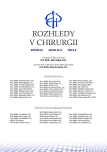Development of structures of intestinal anastomosis and the actual state of their options
Authors:
S. Blažej 1,3; J. Páral 2,3; M. Kaška 3
Authors‘ workplace:
Chirurgické oddělení, Nemocnice Na Homolce, Praha, primář oddělení: MUDr. S. Černohorský
1; Katedra vojenské chirurgie, Fakulta vojenského zdravotnictví UO, Hradec Králové, vedoucí katedry: doc. MUDr. J. Páral, Ph. D.
2; Katedra chirurgie LF UK v Hradci Králové, vedoucí katedry: doc. MUDr. RNDr. M. Kaška, Ph. D.
3
Published in:
Rozhl. Chir., 2015, roč. 94, č. 8, s. 316-321.
Category:
Review
Overview
Colonic anastomosis is believed to be mostly performed in abdominal surgery. Since the 19th century has the enteric anastomosis technique process undergone through major changes as far as sewing materials, devices and the way of bowel reconnection are concerned. Anastomotic dehiscence risk is in some way a motor of constant technical and technological of artificial bowel connection improvement – both in elective and acute operations. In this review authors look back at the above mentioned techniques development of bowel connection and reparation regarding of oncoming experiments focused on ways of bowel anastomosis quality improvement.
Key words:
intestine anastomosis – stapler – sutureless bowel anastomosis – history
Sources
1. Hardy KJ. A view of the development of intestinal suture. Part I. From legend to practice. Aust N Z J Surg 1990;60:299−304.
2. Haddad FS. Suturing methods and materials with special emphasis on the jaws of giant ants (an old-new surgical instrument). J Med Liban 2010;58:53−6.
3. Dietz UA, Debus ES. Intestinal anastomoses prior to 1882; a legacy of ingenuity, persistence, and research form a foundation for modern gastrointestinal surgery. World J Surg 2005;29:396−401.
4. Scott M. 32,000 years of sutures. NATNEWS 1983;20:15−7.
5. Hardy KJ. A view of the development of intestinal suture. Part II. Principles and techniques. ANZ J Surg 1990;60:377−84.
6. Hardy KJ. Non-suture anastomosis: the historical development. ANZ J Surg 1990;60:625−33.
7. Reding R, Kronberger L. Anastomosentechniken, Nahtmaterial und -techniken, Nahtaparate. In: Reding R, et al. Abdominalchirurgie für die Praxis, Band 1. Leipzig, Johann Ambrosius Barth 1987:67−73.
8. Ho YH, Ashour MAT. Techniques for colorectal anastomosis. Word J Gastroenterol 2010;16:1610−21.
9. Nudelman IL, Fuko VV, Morgenstern S, et al. Gastrointestinal anastomosis with the nickel-titanium double ring. World J Surg 2000;24:874−7.
10. Masoomi H, Luo R, Mills S, et al. Compression anastomosis ring device in colorectal anastomosis: a review of 1,180 patients. Am Surg 2013;205:447−51.
11. Buchberg BS, Masoomi H, Bergman H, et al. The use of a compression device as an alternative to hand-sewn and stapled colorectal anastomoses: is three a crowd? J Gastrointestinal Surg 2011;15304−10.
12. Choy PY, Bissett IP, Docherty JG, et al. Stapled versus handsewn methods for ileocolic anastomoses. Cochrane Database Syst Rev 2011;9:CD004320.
13. Shikata S, Yamagishi IH, Taji Y, et al. Single- versus two-layer intestinal anastomosis: a meta-analysis of randomized controlled trials. BMC Surg 2006;27:2.
14. Burch JM, Francoise RJ, Moore EE, et al. Single-layer continuous versus two-layer interrupted intestinal anastomosis: a prospective randomized trial. Ann Surg 2000;231:832−7.
15. Mortensen NJ, Ashraf S. Intestinal anastomosis. In ACS surgery: Principles and practice, BC Decker Inc. 2008;1−14.
16. Baker RS, Foote J, Kemmeter P, et al. The science of stapling and leaks. Obes Surg 2004;14:1290−8.
17. Muffly TM, Tizzano AP, Walters MD. The history and evolution of sutures in pelvic surgery. J R Soc Med 2011;104:107−12.
18. Löffler T, Seiler CHM, Rossion I, et al. Hand-sutire versus stapling for closure of loop ileostomy: HASTA-Trial: a study rationale and desing for a randomized controlled trial. Trials 2011;12:1−10.
19. Lee JY, Woo JH, Choi HJ, et al. Early experience of the compression anastomosis ring (CAR TM 27) in left-sided colon resection. Word J Gastroenterol 2011;17:4787−92.
20. Cai XJ, Yu YCH, Cai HJ, et al. Experimental research of stent anastomosis of gastrojejunostomy in a porcine model. Chin Med J 2011;124:408−12.
21. Ondrák M, Šefr R, Eber Z. Transanální endoskopická mikrochirurgie a její postavení v chirurgii rekta – review. Rozhl Chir 2011;90:450−6.
22. Starý L, Klementa I, Zbořil P, et al. Možnosti transanální endoskopické mikrochirugické techniky. Rozhl Chir 2010;89:770−3.
23. Kocián P, Hoch J. Funkční poruchy po resekci střeva. Rozhl Chir 2015;94:96−102.
24. Fan C, Ma J, Zhang HK, et al. Sutureless intestinal anastomosis with a novel device of magnetic compression anastomosis. Chin Med Sci J 2011;26:182−9.
25. Diana M, Mutter D, Lindner V, et al. A modular magnetic anastomotic device for minimally invasive digestive anastomosis: proof of concept and preliminary data in the pig model. Surg Endosc 2014;28:1613−23.
26. Cilezis I, Thomsen S, Welch AJ, et al. Controlled temperature tissue fusionlaser welding on rat intestine in vivo. Lasers Surg Med 1997;21:269−86.
27. Li ZR, Chi YL, Ke RC. Sutureless end-to-end bowel anastomosis in rabbit using low-power CO2 laser. World J Gastroenterol 2000;6:557−60.
28. Páral J, Subrt Z, Lochman P, et al. Suture-free anastomosis of the colon. Experimental comparison of two cyanoacrylate adhesives. J Gastrointest Surg 2011;15:451−9.
29. Amler E, Mickova A, Buzgo M. Electrospun core/shell nanofibers: a promising system for cartilage and tissue engineering? Nanomedicine 2013;8:509−12.
Labels
Surgery Orthopaedics Trauma surgeryArticle was published in
Perspectives in Surgery

2015 Issue 8
- Metamizole vs. Tramadol in Postoperative Analgesia
- Metamizole at a Glance and in Practice – Effective Non-Opioid Analgesic for All Ages
- Possibilities of Using Metamizole in the Treatment of Acute Primary Headaches
Most read in this issue
- Development of structures of intestinal anastomosis and the actual state of their options
- Von Meyenburg complexes – multiple biliary hamartomas mimicking metastatic liver lesions
- Signet ring cell colorectal carcinom – case report
- Cost-effectiveness of negative pressure wound therapy in outpatient setting
